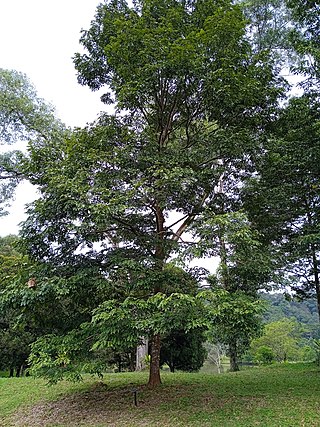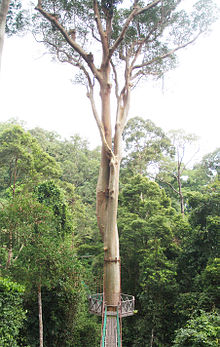
Buttress roots, also known as plank roots, are large, wide roots on all sides of a shallowly rooted tree. Typically, they are found in nutrient-poor tropical forest soils that may not be very deep. They may prevent the tree from falling over.

Koompassia malaccensis is a tropical rainforest tree species up to 60 m tall in the bean family (Fabaceae) and the pea subfamily (Papillionidae). It is native to Peninsular Malaysia, Singapore, Borneo and Thailand. It is among the tallest rainforest trees in the world, with one individual reaching 264 ft 10in in height. It is threatened by habitat loss. A common name for this wood is kempas, it is used as a flooring material.

The Lambir Hills National Park is a national park in Miri Division, Sarawak, Malaysia, on the island of Borneo. It is a small park, at 6,952 hectares, and is composed largely of mixed dipterocarp forest, with some small areas of 'kerangas'. The park is 150–465 m (492–1,526 ft) above sea level.
Hopea aequalis is a tree in the family Dipterocarpaceae, native to Borneo. The specific epithet aequalis means "equal" and refers to the lobes of the fruit's calyx.
Hopea griffithii is a tree in the family Dipterocarpaceae. It is named for the British doctor and naturalist William Griffith.
Hopea longirostrata is a tree in the family Dipterocarpaceae, native to Borneo. The specific epithet longirostrata means "long-beaked", referring to the shape of the fruit.
Hopea micrantha is a tree in the family Dipterocarpaceae. The specific epithet micrantha means "small flower".
Hopea nutans is a large rainforest tree species in the family Dipterocarpaceae. It is found in Peninsular Malaysia and Borneo. The tallest measured specimen is 82.8 m tall in the Tawau Hills National Park, in Sabah on the island of Borneo.
Hopea pentanervia is a tree in the family Dipterocarpaceae, native to Borneo. The specific epithet pentanervia means "five-nerved", referring to the species' five pairs of leaf veins.
Hopea sangal is a tree in the family Dipterocarpaceae. It is native to tropical Asia.
Shorea gibbosa is a large emergent rainforest tree species in the family Dipterocarpaceae. It is native to Sumatra, Borneo, Peninsular Malaysia and Singapore. The tallest measured specimen is 81.1 metres tall, in the Tawau Hills National Park, in Sabah on the island of Borneo.

The Borneo lowland rain forests is an ecoregion, within the tropical and subtropical moist broadleaf forests biome, of the large island of Borneo in Southeast Asia. It supports approximately 15,000 plant species, 380 bird species and several mammal species. The Borneo lowland rain forests is diminishing due to logging, hunting and conversion to commercial land use.

Dinizia excelsa is a South American canopy-emergent tropical rainforest tree species in the family Fabaceae, native to primarily Brazil and Guyana. In Portuguese it is known as angelim-vermelho, angelim, angelim-pedra, and paricá, or sometimes angelim-falso, faveira, faveira-dura, faveira-ferro or faveiro-do-grande. In Trio it is called awaraimë. In Wapisiana it is called parakwa.
Hopea andersonii is a tree in the family Dipterocarpaceae, native to Borneo. It is named for J. A. R. Anderson, a forest officer on the island.
Hopea bullatifolia is a tree in the family Dipterocarpaceae, native to Borneo. The specific epithet bullatifolia means 'blistered leaf'.
Hopea cernua is a tree in the family Dipterocarpaceae. The specific epithet cernua means 'slightly drooping', referring to the flowers.
Hopea rudiformis is a tree in the family Dipterocarpaceae, native to Borneo. The specific epithet rudiformis means 'sword-shaped', referring to the leaf.
Hopea tenuinervula is a tree in the family Dipterocarpaceae, native to Borneo. The specific epithet tenuinervula means 'slender nerve', referring to the leaf veins.
Hopea treubii is a tree in the family Dipterocarpaceae, native to Borneo. It is named for the Dutch botanist Melchior Treub.
Hopea wyattsmithii is a tree in the family Dipterocarpaceae, native to Borneo. It is named for the botanist John Wyatt-Smith.







